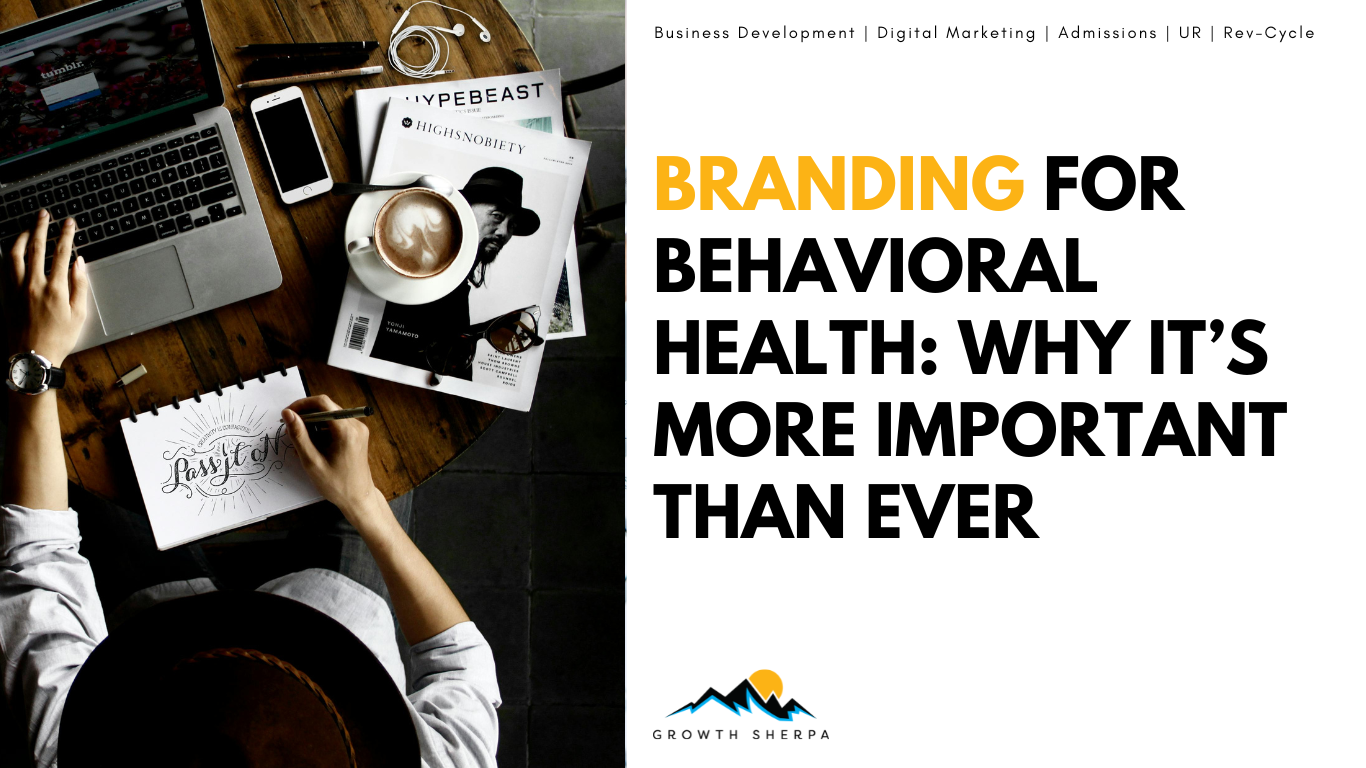Branding is often associated with consumer products — think of the instantly recognizable logos, slogans, and colors of companies like Nike, Coca-Cola, or Apple. But branding is not just for tech giants or soda companies; it’s a vital part of any business, including those in the behavioral health and addiction treatment industries. In a field where trust, empathy, and a connection with potential patients are critical, branding plays an increasingly pivotal role.
Branding for behavioral health and addiction treatment centers is about more than a catchy logo or a polished website. It’s about building an emotional connection with patients, their families, and referral sources. As healthcare becomes more consumer-driven, people are looking for treatment providers that they can trust — providers who understand their struggles and can offer a clear path to recovery. In this blog, we’ll explore why branding for behavioral health is more important than ever and how it can shape your facility’s success.
Why Branding Matters in Behavioral Health
The days when a healthcare provider could rely solely on their reputation or location to attract patients are long gone. With the rise of digital marketing and increasing competition, especially in the addiction treatment sector, patients and families have more choices than ever. They can research and compare multiple treatment centers before making a decision. That’s where branding comes in.
Your brand is your facility’s identity. It encompasses everything from your logo and website to the tone of your messaging and the values you communicate. More importantly, your brand is the story you tell about who you are and how you help patients recover. In behavioral health, where the patient’s journey is deeply personal, branding must convey trust, compassion, and expertise.
In other words, your brand is often the first impression a potential patient or their family will have of your facility. A strong, consistent brand can set you apart from competitors and instill confidence in those seeking care.
What Makes a Successful Brand in Behavioral Health?
Branding in the behavioral health space requires a delicate balance. On the one hand, you need to communicate clinical expertise and professionalism. On the other hand, behavioral health is deeply personal, and your brand needs to reflect empathy, compassion, and understanding of the challenges patients are facing.
Here are the key elements of a successful brand in behavioral health:
- Clarity of Mission: What does your facility stand for? What makes your approach to treatment unique? Your brand should clearly communicate your mission and values, whether it’s a holistic approach to recovery, a focus on dual-diagnosis treatment, or a commitment to long-term sobriety support. Clarity of mission helps patients understand what sets your facility apart from others.
- Consistency: Branding is not just about having a nice logo or tagline. It’s about delivering a consistent message across every touchpoint — from your website to your social media to your in-person interactions. If your branding is inconsistent, it can confuse potential patients or make them question the professionalism of your facility.
- Emotional Connection: Branding should tap into the emotions of potential patients. Addiction and mental health struggles are often accompanied by fear, anxiety, and uncertainty. A strong brand provides reassurance. Your messaging, imagery, and overall tone should create a sense of safety, hope, and trust.
- Authenticity: Authenticity is crucial in behavioral health branding. Patients are looking for genuine help, and they can quickly sense if your branding feels forced or disingenuous. Your brand needs to authentically reflect the experience you provide. This includes using real testimonials, stories of recovery, and showcasing your staff’s dedication to patient care.
How to Build a Brand that Resonates with Your Audience
Branding isn’t a one-size-fits-all approach. It requires deep understanding of your audience and what matters to them. In the behavioral health industry, your audience includes not only patients but also their families, referral sources, and even insurance providers. Here’s how you can build a brand that resonates with this diverse audience:
- Define Your Audience’s Needs: To create a brand that speaks to your audience, you need to understand their needs. For potential patients, it could be finding a place that feels safe, non-judgmental, and focused on recovery. For families, it might be the need for clarity, support, and transparency. Your brand should address these needs in a way that speaks directly to their concerns.
- Develop a Strong Visual Identity: Your visual identity is the face of your brand. This includes your logo, color scheme, website design, and overall aesthetic. In behavioral health, it’s often best to use soothing colors and calming designs that evoke a sense of trust and safety. Avoid anything that feels too corporate or cold, as patients are looking for a more compassionate and approachable vibe.
- Create Compelling Messaging: Your messaging is just as important as your visuals. It needs to be clear, compassionate, and empowering. Think about the tone of voice you use in your website copy, social media posts, and advertising campaigns. Are you addressing the pain points of your patients? Are you offering hope and a path to recovery? Messaging should be straightforward but empathetic, always keeping the patient’s journey in mind.
- Leverage Patient Stories and Testimonials: One of the most powerful branding tools for addiction treatment centers is patient testimonials. Stories of real patients who have successfully completed your program and achieved recovery resonate deeply with those who are struggling. They show potential patients that recovery is possible and that your facility has a track record of success.
- Engage Through Digital Channels: In today’s digital-first world, your brand needs to be visible across multiple platforms. This includes having a professional website, engaging social media presence, and digital advertising campaigns. Digital channels provide an opportunity to showcase your brand’s values, share patient success stories, and engage with your audience in real time.
Real-World Examples of Behavioral Health Brands That Work
Several behavioral health and addiction treatment providers have successfully created strong, resonant brands that not only attract patients but also instill trust in their services. Let’s look at a few examples:
- Promises Treatment Centers: Promises has built its brand around hope and personalized recovery journeys. Their website is full of success stories and offers a calm, inviting design. Their messaging consistently emphasizes long-term recovery, family involvement, and a compassionate, individualized approach to care.
- Hazelden Betty Ford: As one of the most recognized names in addiction treatment, Hazelden Betty Ford has built its brand on expertise and a legacy of proven care. Their visual identity is professional yet welcoming, and their messaging focuses on trust, recovery, and the science of addiction treatment.
- The Meadows: The Meadows specializes in trauma-focused treatment, and their brand reflects this with messaging that focuses on healing the root causes of addiction. Their website emphasizes empathy, expertise, and holistic care, with calming imagery that aligns with their therapeutic approach.
Branding Mistakes to Avoid
While branding offers many benefits, there are also pitfalls to watch out for in the behavioral health industry:
- Over-Promising: Avoid making unrealistic promises in your branding, such as guaranteed recovery or immediate results. Addiction and mental health treatment is a complex process, and patients need to feel like they’re being offered realistic, achievable outcomes.
- Inconsistent Messaging: If your website, social media, and in-person interactions don’t align with each other, potential patients may feel confused or distrustful. Make sure your branding is consistent across all channels.
- Neglecting the Human Element: Behavioral health is a people-centered industry, and your brand needs to reflect that. Avoid sterile, corporate language and focus instead on compassionate, patient-focused messaging.
In today’s competitive healthcare environment, branding for behavioral health and addiction treatment centers is more important than ever. A strong brand can set your facility apart, build trust with potential patients, and ultimately drive more admissions. By focusing on clarity, consistency, emotional connection, and authenticity, your facility can create a brand that resonates with those who need your services. Branding is not just about aesthetics — it’s about building relationships and conveying a sense of hope and professionalism. In the end, a well-executed brand can be the difference between a potential patient choosing your facility or another. In behavioral health, that choice could change — and even save — lives.


